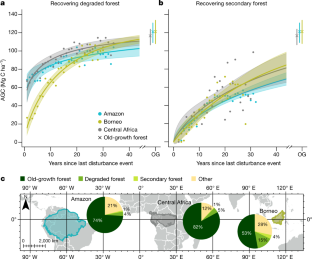2023-03-22 カーディフ大学
◆この研究は、世界で最も大きな3つの熱帯林での衛星データを使用して、大気からどれだけの炭素が除去されているかを調査しました。この研究は、カーディフ大学の専門知識を活用し、ブリストル大学のチームとアメリカとヨーロッパの環境科学者が主導しました。
◆現在、私たちの炭素フットプリントを軽減する方法として、樹木植樹に大きな焦点が当てられています。しかし、先に伐採された森林の重要性を考慮することなく、荒れ地を回復することに焦点を当てるべきです。
◆この研究は、大気中から炭素を貯蔵する方法として、これらの荒れた劣化した森林を保存することが重要であることを示しています。
<関連情報>
- https://www.cardiff.ac.uk/news/view/2711550-recovering-tropical-forests-offset-just-one-quarter-of-carbon-emissions-from-new-tropical-deforestation-and-forest-degradation,-study-finds
- https://www.nature.com/articles/s41586-022-05679-w
湿潤熱帯二次林および劣化した熱帯林の炭素吸収量について The carbon sink of secondary and degraded humid tropical forests
Viola H. A. Heinrich,Christelle Vancutsem,Ricardo Dalagnol,Thais M. Rosan,Dominic Fawcett,Celso H. L. Silva-Junior,Henrique L. G. Cassol,Frédéric Achard,Tommaso Jucker,Carlos A. Silva,Jo House,Stephen Sitch,Tristram C. Hales & Luiz E. O. C. Aragão
Nature Published:15 March 2023
DOI:https://doi.org/10.1038/s41586-022-05679-w

Abstract
The globally important carbon sink of intact, old-growth tropical humid forests is declining because of climate change, deforestation and degradation from fire and logging1,2,3. Recovering tropical secondary and degraded forests now cover about 10% of the tropical forest area4, but how much carbon they accumulate remains uncertain. Here we quantify the aboveground carbon (AGC) sink of recovering forests across three main continuous tropical humid regions: the Amazon, Borneo and Central Africa5,6. On the basis of satellite data products4,7, our analysis encompasses the heterogeneous spatial and temporal patterns of growth in degraded and secondary forests, influenced by key environmental and anthropogenic drivers. In the first 20 years of recovery, regrowth rates in Borneo were up to 45% and 58% higher than in Central Africa and the Amazon, respectively. This is due to variables such as temperature, water deficit and disturbance regimes. We find that regrowing degraded and secondary forests accumulated 107 Tg C year−1 (90–130 Tg C year−1) between 1984 and 2018, counterbalancing 26% (21–34%) of carbon emissions from humid tropical forest loss during the same period. Protecting old-growth forests is therefore a priority. Furthermore, we estimate that conserving recovering degraded and secondary forests can have a feasible future carbon sink potential of 53 Tg C year−1 (44–62 Tg C year−1) across the main tropical regions studied.



